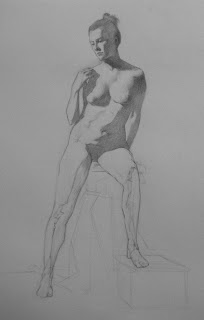"The Cabinet"
12 x 16 inches, oil on panel, work in progress
It feels so good to be working on one of my still lifes again! This is the "Open Grisaille" underpainting - essentially just Raw Umber and turp, an initial pass at roughing in the basic values. I tell my students that at this stage you just have to accept some ugliness, it's impossible to make this thin, brushy layer look pristine.
Some artists do this stage as a "wipe-out", where they tone the whole panel and then wipe away the highlights. I don't do this because I find it wipes away my drawing too much, and lacks a certain level of precision. This layer is painted very thin, and I tell my students to think of "kissing" the contours with the tip of the brush, to avoid a hard, unthinking swipe along those carefully-drawn contours.
 12 x 16 inches, graphite on panel, preparatory drawing
12 x 16 inches, graphite on panel, preparatory drawingI started the drawing on Mylar drawing vellum (I like a brand called "Dura-Lar" - be careful not to buy the clear acetate in the similar packaging though). Then I transferred the blocked-in drawing to the panel before refining it. I always do the last few hours of refining the drawing directly on the panel, to avoid that dead "traced" look. That way every contour has been drawn from life right on the panel. I use the Mylar stage of the drawing for blocking in proportions and finalizing the composition.
The contour drawing is hard to photograph because the final lines are so thin and light, so I had to tweak the photo quite a bit in Photoshop, which is why it looks somewhat "dirty".
Once the drawing is finished I seal the panel with a coat of Dammar with some turp mixed in. This protects the drawing from being wiped away, and also makes the panel less "thirsty". Now it's a perfect surface to paint on.
-----------------------
Teaching schedule:
I'm always adding new classes, open model sessions, workshops and demos to my
Teaching Page!












































